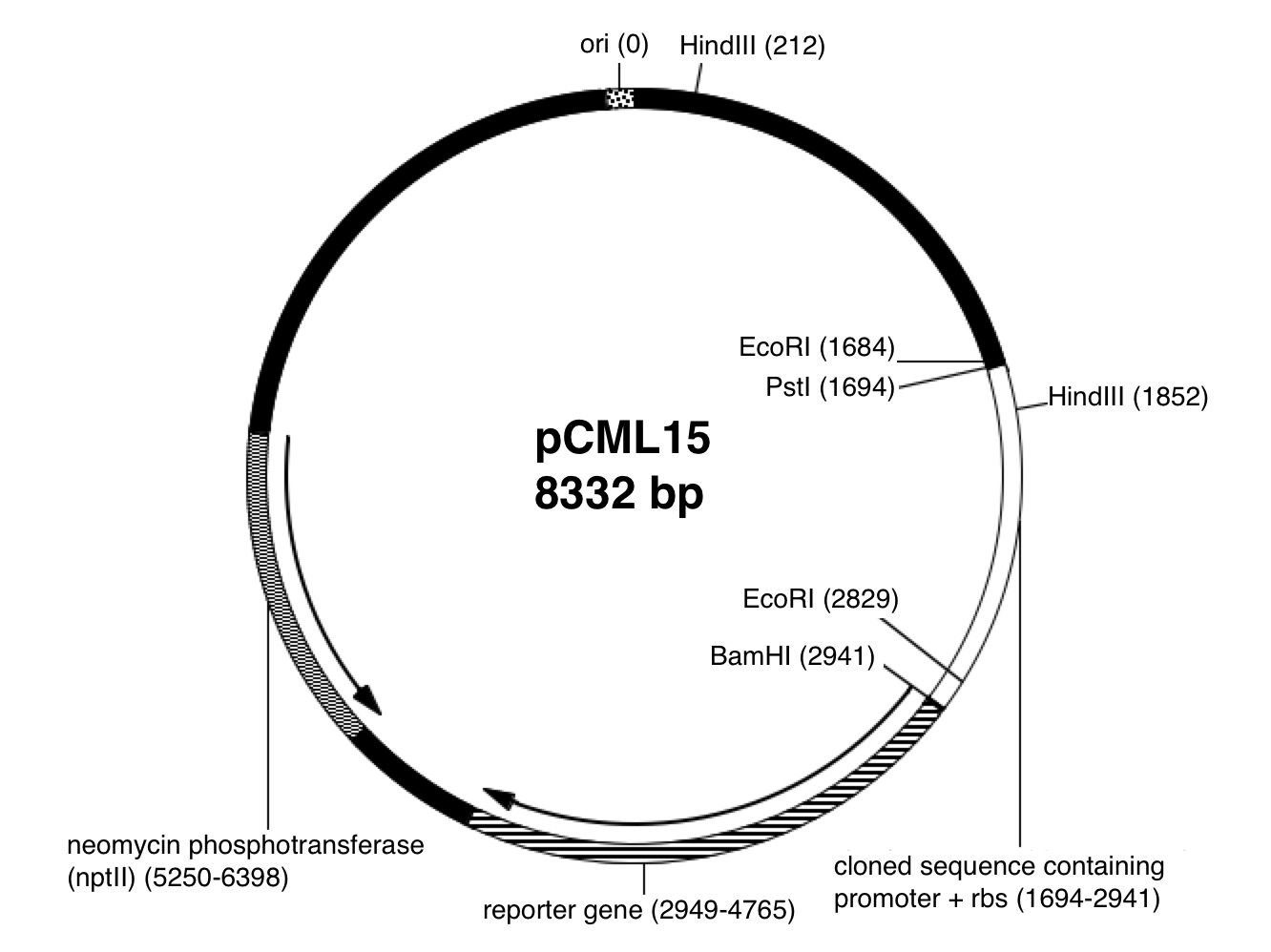 |
Experience is one thing you can't get for nothing. |
Home
Lab Resources
- Agarose Gel Electrophoresis
- Bacterial Streak Plate
- Bacterial Transformation
- DNA Ligation
- PCR
- Pipettors
- Plasmid DNA Isolation and Restriction Enzyme Digests
- Preparation of Agar Plates
Pre-lab Preparation
- Laboratory Citizenship & Performance
- BioSciences Lab Program Honor Code
- Molecular Biology Tips
- Writing Up Methodology
Additional Resources
Plasmid DNA Isolation and Restriction Enzyme Digests
Plasmid DNA mini preps and restriction enzyme digests are "staples" in a laboratory that works with DNA. Your experience with these methods will be greatly appreciated if you take on a project in such an environment. The challenge is to conduct each procedure exactly as instructed. Molecular biology requires faithful attention to details. Deviation from an established protocol almost always result in failed preparations.
PLASMID DNA
| Plasmids are small circles (usually less than 15 kb)
of double stranded DNA maintained in some bacteria because they confer
an advantage to the cells such as resistance to an antibiotic. The
ease with which this DNA can be isolated and manipulated accounts
for the widespread use of plasmids in molecular biology for a variety
of tasks (e.g., protein expression). Although plasmids occur naturally,
the ones used in research have been engineered to prevent natural
transfer between bacteria to reduce the spread of antibiotic resistance.
Plasmids used for protein expression in E.coli need to have:
|
 |
|---|
RESTRICTION ENZYMES
Restriction enzymes cleave the phosphodiester bonds in each strand of double-stranded DNA. The cleavage may be at adjacent sites leaving a “blunt end,” or the cut may be offset by 1 to 4 bases, leaving either a 3' overhang or a 5' overhang of a single strand. The offset cleavage yields "sticky end" cuts.
Restriction enzymes are obtained from many prokaryotes and about 1500 enzymes with known sequence recognition sites have been isolated. Naming these endonucleases follows a system proposed by Nathans and Smith. Each name contains at least one capital letter and two small letters followed by a Roman numeral. The letters are initials of the genus and species of origin and the number represents the number of enzymes discovered in the organism. (Historically the numeral identified the protein peak in which the enzyme eluted during chromatography.) Additional information may be added as a letter. For EcoRI, the R indicates the particular strain of E. coli.
A few buffer conditions suit nearly all the restriction enzymes but no single buffer allows activity of every enzyme. Suppliers of enzymes always provide a reaction buffer (10x concentrate) that is optimum for the enzyme. Components of the 1x buffer usually are 10-100 mM Tris at pH 7.3 to 8.5, various levels of salts like KCl and NaCl (10 to 150 mM), 10 mM Mg(2+), 2 mM beta-mercaptoethanol. Sometimes 0.01% Triton- X100 (a detergent) and bovine serum albumin are included as a stabilizers. (Alternatively, swine skin gelatin can be used and offers the advantages that it is stable to autoclaving and costs about 1/15 as much as BSA.)
Since restriction enzymes can require different buffer conditions, some strategy must be used to do double digests. The preferred method is to simultaneously digest with both enzymes in a compatible buffer. This method can be used even if one enzyme is not fully active (e.g., 75% active). More of one enzyme can be added (e.g., 1 U of enzyme A + 1.33 U enzyme B) for equal cutting efficiency. There are limits to the excess enzyme due to increased glycerol in the reaction that can reduce specificity of some enzymes. An alternative method is to digest with the "low salt" enzyme then add more buffer and the "high salt" enzyme to complete the digest. This obviously doubles the time required for digestion. In extreme cases the DNA can be precipitated after one digest and dissolved in the second digest buffer. Digests are carried out at 37 degrees C unless otherwise noted for the enzyme.
Miscellaneous information on restriction enzymes
- By definition, a unit of restriction enzyme will completely cleave 1µg of Lambda DNA (or other substrate DNA) in one hour in the recommended buffer and temperature.
- Reaction volumes should be 25-50 µl and the amount of enzyme added should not exceed 10% of the volume due to the glycerol content. The amount of DNA in a digest should not exceed 250 µg/ml because the increase in ionic compounds in the DNA preparations will decrease the efficiency of cleavage.
- Restriction enzymes are most stable when stored in a non-cycling -20 degrees C freezer. (Frost-free freezers are not recommended.) Most enzymes are stored in 50% glycerol and therefore are not frozen solid, allowing removal of the enzyme without thawing. Always keep the enzyme solution in a freezer block (e.g., a “Stratacooler”) and return it to the freezer as quickly as possible.
- Catalogues from suppliers represent an accessible (and free) source of valuable information on restriction enzymes. A wealth of information is usually found in table form in appendices in the back of the catalogue or near the pages listing the restriction enzymes. These tables give buffer concentrations, recognition sequences, E. coli strains and genotype tables, and more. New England Biolabs and Promega are exceptionally efficient at providing information; additionally, both companies provide several useful web-based resources.
Experimental overview
Today’s procedures involve isolating plasmid DNA and digesting DNA with restriction enzymes. Make sure that you use the appropriate pipettor and set the volume correctly—if you’re unsure, then ask. Record all procedures and data in your lab notebook, indicating “who” performed a specific procedure step; turn in copies of notebook pages at the end of the laboratory session.
SPECIAL NOTE: Record enough procedure details in your notebook during lab today so that you can repeat these procedures using your notebook as the ONLY resource. Write the methods in your own words (i.e., do not just “copy” the steps from the web pages or handouts).
ADDITIONAL DETAILS: for each centrifugation, record time, rcf (# x g), and temperature in your lab NB; ALL centrifugations performed in the microcentrifuges are at “room temperature” (indicate as such but don't need to report in degrees C)
A) Plasmid DNA mini prep
We're using a Zyppy™ Plasmid Miniprep Kit (Zymo Research Corp., Irvine, CA) to isolate plasmid DNA from an overnight (O/N) bacterial culture in Luria-Bertani (LB) broth with the appropriate antibiotic. Follow the manufacturer's recommended protocol and document each step, including any deviations to the protocol or mistakes in procedures, in your lab notebook.- Disposal of Waste: discard bacterial supernatant and collect contaminated tips in a small beaker; we will add bleach to 10% for 10 minutes before dumping into the trash and sink
- Place culture tubes in the clear Biohazards bag; these bags will be autoclaved prior to placement in the household trash
- After the bacteria are lysed, tips, vials, and other materials should be discarded in the regular trash and sink
B) Restriction enzyme (RE) digests of plasmid DNA
Our restriction enzymes are from New England Biolabs (NEB) (Ipswich, MA); record the units/µl for each enzyme you use--this information as well as buffer components (1X) for each buffer can be found on the manufacturer’s inserts or online. What digest reactions will you need to set-up to confirm the identity of the plasmid DNA?Just for Fun
Check out Cut It Out, a strategy game about restriction enzymes from New England Biolabs.We would like to thank New England Biolabs for their generous support of our laboratory program
Visitors: to ensure that your message is not mistaken for SPAM, please include the acronym "Bios211" in the subject line of e-mail communications
Created by David R. Caprette (caprette@rice.edu), Rice University 14 Jul 08
Author: Beth Beason Abmayr, Ph.D., Rice University
Updated 2 July 2014
